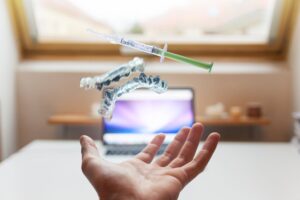Introduction
Welcoming you all to another post on a topic that’s critical to every parent out there – baby teeth X-ray. As guardians, we constantly worry about our little one’s health, and more often than not, oral care is a part of that concern. However, it’s common to overlook the importance of baby teeth since they eventually fall out. But did you know, these primary teeth set the groundwork for the adult teeth waiting to replace them?
In this comprehensive guide, we’re going to dive deep into the world of baby teeth X-rays, shedding light on the significance of your child’s oral care. Ever wondered why a dentist might suggest an X-ray for your child’s baby teeth? Or perhaps you’re curious about the safety and procedure of these X-rays. We’ll walk you through all of this and more, helping you make informed decisions about your child’s dental health.

In this post, we’ll cover:
- The importance of baby teeth
- What exactly is a baby teeth X-ray
- The necessity of baby teeth X-rays
- The procedure of a baby teeth X-ray
- Interpreting the results of a baby teeth X-ray
- Helpful tips for parents
Let’s embark on this journey of understanding the fascinating world of baby teeth X-rays, and how they contribute to your child’s radiant smile and overall health.
Stay tuned for a detailed discussion on these topics, and don’t forget to share your experiences or ask questions in the comment section!
The Importance of Baby Teeth
When it comes to our little ones, we, as parents, often ponder, “Why should we worry about baby teeth if they’re going to fall out anyway?” The answer is – because they’re much more important than we think!
Guiding the Adult Teeth
Baby teeth, or primary teeth, are the first set of teeth that appear in a child’s mouth. Their main role is to hold the space for the future adult teeth and guide them into the correct position. If a baby tooth is lost too early due to decay or any other reason, it can lead to space loss for the permanent tooth, causing them to come in crooked or in the wrong position.
Role in Speech and Facial Structure
Next, baby teeth play a crucial role in your child’s speech development. They help children pronounce words correctly, allowing them to communicate clearly. Plus, they contribute to the normal development of the jawbones and muscles, affecting the shape and appearance of your child’s face.
Eating and Nutrition
Another aspect of baby teeth is they help children eat and chew properly, thus aiding in digestion and nutrition. Remember, good nutrition is vital for a child’s overall development, and baby teeth play an essential part in that.
Learning Good Dental Habits
Lastly, baby teeth are the first stepping stones to instill good oral hygiene habits in children. Teaching them how to brush and floss at an early age not only keeps their baby teeth healthy but also prepares them for lifelong dental health.
So, you see, the importance of baby teeth goes beyond their temporary existence in your child’s life. They’re the forerunners for your child’s permanent teeth, help in speech and facial structure, assist in eating and nutritional absorption, and most importantly, they’re the practice grounds for good dental habits.
Up next, we will delve into the topic of baby teeth X-rays, explaining what they are and why they’re needed. Stay tuned!
What is a Baby Teeth X-Ray?
Having understood the significance of baby teeth in your child’s development, it’s time we discuss a key tool in pediatric dentistry that ensures these teeth are healthy – the Baby Teeth X-Ray.
Defining Baby Teeth X-Ray
Baby teeth X-rays, also known as pediatric dental X-rays, are imaging techniques used by dentists to view your child’s teeth and jaws in detail. X-rays help them see beyond what the naked eye can capture, giving an in-depth look at the teeth, their roots, and the jaw bones. It’s like having a superpower to see through the surface and into the hidden aspects of oral health!
Purpose of a Baby Teeth X-Ray
So why do dentists take X-rays of your child’s teeth? Well, there are several reasons.
- Cavity Detection: Baby teeth are more susceptible to cavities than adult teeth due to their thinner enamel. An X-ray can detect these cavities, even the ones that are in between teeth or under the gum line.
- Monitoring Tooth Development: Baby teeth X-rays allow dentists to monitor the development and positioning of both primary and upcoming permanent teeth. It helps them foresee any potential issues and intervene early if needed.
- Assessing Oral Damage: In case of dental injuries or trauma, X-rays can assess the extent of the damage, which aids in the planning of effective treatment.
- Identifying Oral Diseases: Finally, X-rays can help identify any oral diseases that may not be visible during a routine oral examination, such as cysts, tumors, or abscesses.
In a nutshell, a baby teeth X-ray is a vital tool in pediatric dentistry that allows dentists to detect dental problems early, plan treatment effectively, and ultimately ensure your child’s oral health is in tip-top shape.
But, you might wonder, is this procedure really necessary? And how safe is it for your child? Keep reading as we discuss these concerns in the upcoming sections.
Why are Baby Teeth X-Rays Necessary?
Given the insight into what a baby teeth X-ray is, the next logical question is – why are these X-rays necessary? Are they really that vital in maintaining our children’s dental health? Let’s discuss this.
Early Detection of Dental Issues
One of the primary benefits of baby teeth X-rays is that they facilitate the early detection of dental issues. Even before a problem becomes visible or causes any discomfort to your child, an X-ray can help spot it. This allows for timely intervention, preventing the escalation of minor issues into major ones.
Visualizing Hidden Areas
Baby teeth X-rays provide a detailed view of areas that are otherwise not visible during a routine dental check-up. This includes the inside of the teeth, the roots, the areas between teeth, and the jawbone. Such a comprehensive view allows for a thorough assessment of your child’s dental health.
Monitoring the Development of Permanent Teeth
As we discussed earlier, baby teeth are placeholders for the adult teeth. X-rays help monitor the development, positioning, and health of these underlying permanent teeth. This way, any developmental anomalies can be identified and addressed early on.
Customized Treatment Planning
Finally, baby teeth X-rays are instrumental in devising a customized treatment plan in case of dental diseases or injuries. They provide key information that helps the dentist understand the extent of the problem and plan the most effective treatment approach.
So, in short, the necessity of baby teeth X-rays lies in their ability to enable early dental issues detection, visualize hidden areas of the mouth, monitor the development of permanent teeth, and assist in the customization of treatment plans. They are an invaluable tool for maintaining your child’s oral health.
Convinced about the necessity but still anxious about the process? Stay tuned as we unravel the procedure of a baby teeth X-ray, addressing your concerns about safety and comfort in the next section.
The Procedure of a Baby Teeth X-Ray
Having established the necessity of baby teeth X-rays, it’s time we explore the procedure. We understand it can seem a bit intimidating, especially when it involves your little ones. Don’t worry; we’re here to walk you through it and answer your questions on safety and discomfort associated with the process.
Preparation
First, let’s talk about preparation. There’s not much you need to do in terms of preparing your child for a dental X-ray. Just ensure your child’s teeth are clean by having them brush and floss before the appointment. Also, explain to them what to expect in simple terms to help alleviate any anxiety.
Safety Measures
Safety is a primary concern during a baby teeth X-ray. Thankfully, dental X-rays use a very low level of radiation and are considered safe for children. However, to minimize any risk, the dentist will use a lead apron to cover your child’s body, which prevents unnecessary radiation exposure.
Types of X-rays and Their Process
There are several types of baby teeth X-rays, each serving a different purpose:
- Bite-Wing X-rays: For this type, your child will be asked to bite down on a piece of plastic with X-ray film in the center. This X-ray shows the upper and lower back teeth in a single view and is typically used to detect decay between the teeth.
- Periapical X-rays: These focus on one or two teeth at a time, providing a view from the crown to the root where the tooth attaches into the jaw. Your child will be asked to bite on a small holder that keeps the X-ray film in place while the images are taken.
- Panoramic X-rays: This X-ray gives a broad view of the entire oral cavity, providing information about the teeth, upper and lower jawbones, sinuses, and other hard and soft tissues of the head and neck. Your child will be asked to bite on a special tool and remain still while the X-ray machine rotates around their head.
- Occlusal X-rays: These are used to track the development and placement of an entire arch of teeth in the upper or lower jaw. The X-ray film is placed on the biting surface of the teeth and the child is asked to close their mouth gently on the film.
During each of these X-rays, the dentist or dental technician will carefully position the X-ray machine at just the right angle to get the needed images.
So, the procedure of a baby teeth X-ray involves very little preparation, incorporates safety measures, and may involve different types of X-rays based on the dentist’s evaluation.
Up next, we’ll talk about how these X-ray results are interpreted. What do those ghostly images mean, and how do they help the dentist plan your child’s treatment? Stay tuned to find out!
Interpreting Baby Teeth X-Ray Results
After understanding the procedure, it’s natural to wonder, “What next?” Well, the next step is the interpretation of these X-ray results. The shadowy images might look like cryptic hieroglyphics to the untrained eye, but to your dentist, they’re a treasure trove of information!
Understanding Dental X-Ray Results
Your child’s dentist or a radiologist will analyze the X-ray images to evaluate your child’s dental health. Here’s what they typically look for:
- Decay: Dark spots or patches on teeth may indicate areas of decay. Even the tiniest spot of decay that is not visible to the naked eye can be picked up in an X-ray.
- Gum Disease: Darkened or reduced bone around the teeth can point towards gum diseases, which might need further treatment.
- Developmental Issues: The X-ray can show the position, size, and number of both the visible teeth and the ones yet to erupt. This can help in identifying any developmental issues such as impacted teeth, extra or missing teeth, and other abnormalities.
- Infections or Abscesses: Dark spots at the tip of the tooth root usually signify an infection or an abscess.
- Injuries or Trauma: In the case of any injury or trauma, the X-ray will help assess the extent and type of damage, such as a fracture.
Planning the Treatment
Based on the understanding of the dental X-ray results, your dentist will then create a treatment plan, if required. This might involve procedures to treat cavities, gum diseases, infections, or developmental issues.
In conclusion, interpreting a baby teeth X-ray isn’t just about diagnosing dental problems; it’s also about effective treatment planning. It’s a crucial step in ensuring your child’s oral health is on the right track.
Up next, let’s look at some tips and advice for parents to ease this process for their little ones, and to ensure their overall oral health. Keep reading!
Tips for Parents
As we walk you through the journey of baby teeth X-rays, we understand that as parents, you play the most vital role in this process. Here, we’ve compiled some tips to help you prepare for your child’s X-ray and maintain their dental health.
Preparing for Baby Teeth X-Ray
- Talk to Your Child: Use simple language to explain what will happen during the X-ray. Assure them that it’s a quick and painless procedure.
- Lead by Example: Show them how you undergo dental check-ups and X-rays without any fear. This will encourage them to do the same.
- Play Pretend: Role-playing the X-ray process can make your child feel more comfortable when the actual procedure takes place.
Child Dental Care Tips
- Start Early: Start cleaning your child’s teeth as soon as the first tooth erupts. Use a soft-bristled toothbrush and a smear of fluoride toothpaste.
- Healthy Diet: Limit sugary foods and drinks in your child’s diet. Encourage them to drink water and eat a balanced diet for healthy teeth and gums.
- Regular Check-ups: Regular dental check-ups are key to early detection and treatment of dental issues. Ensure you follow the dentist’s recommended schedule.
- Fluoride Use: Fluoride strengthens the enamel and helps prevent cavities. Ask your dentist when and how to introduce fluoride products to your child.
- Teach Oral Hygiene Habits: Teaching good oral hygiene habits at an early age sets the stage for lifelong dental health. Teach them the correct way to brush and floss.
- Avoid Bottle Decay: Don’t put your child to bed with a bottle. This can lead to baby bottle tooth decay.
Remember, as parents, you are the first line of defense in your child’s oral health. Following these tips will not only prepare your child for a baby teeth X-ray but also ensure they maintain a healthy and bright smile.
Up next, we’ll wrap up our discussion and emphasize why everything we’ve learned today is so important for your child’s overall health. Stay with us!
Conclusion
Our journey exploring the realm of baby teeth X-rays has brought us a wealth of knowledge. We’ve learned about the significant role baby teeth play in a child’s development, the essence of baby teeth X-rays, the process involved, and how to interpret the results. It’s clear now that baby teeth X-rays are an invaluable tool for ensuring the health of your child’s teeth, serving as a critical component in the early detection and treatment of dental issues.
Remember, the oral health of your child today plays a significant role in their overall health in the future. By being proactive and attentive about their dental health, you’re setting them up for a lifetime of bright and healthy smiles.
As parents, we know you strive to do the best for your children, and taking care of their dental health is a major part of that. Keep following the tips we shared and continue to educate yourself about your child’s oral health needs.
Thank you for taking the time to read through this guide. We hope it’s been helpful and has answered many of your questions about baby teeth X-rays.
In the next post, we’ll be exploring more about children’s dental health. Stay tuned, and until then, keep smiling!



